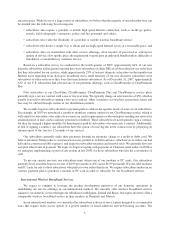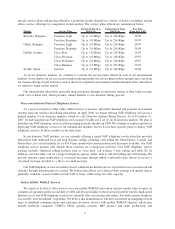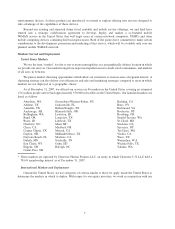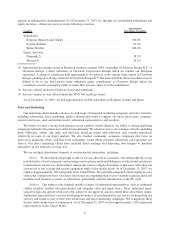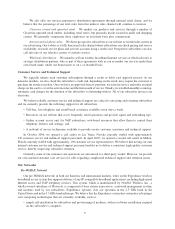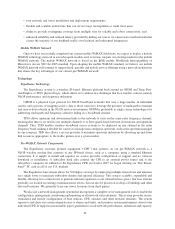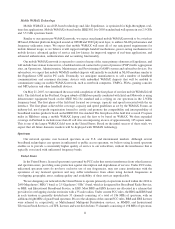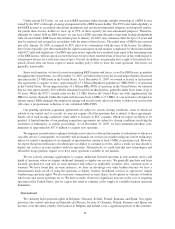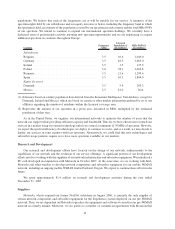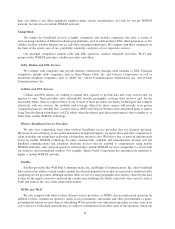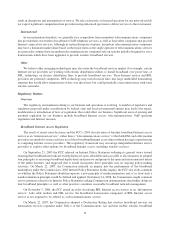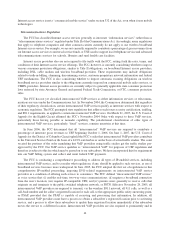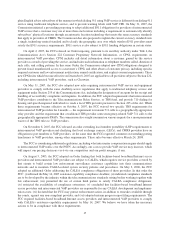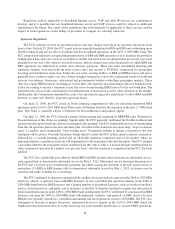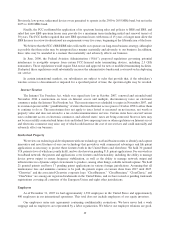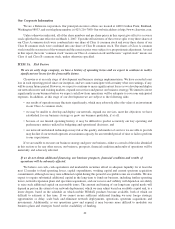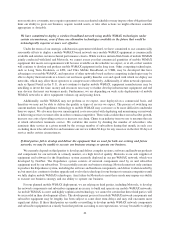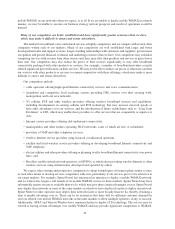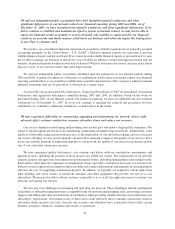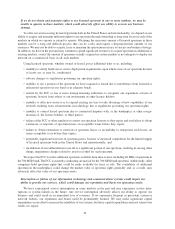Clearwire 2007 Annual Report Download - page 23
Download and view the complete annual report
Please find page 23 of the 2007 Clearwire annual report below. You can navigate through the pages in the report by either clicking on the pages listed below, or by using the keyword search tool below to find specific information within the annual report.result in disruptions and interruptions of service. We rely exclusively on licensed spectrum for our network and do
not expect significant competition from providers using unlicensed spectrum to deliver services to their customers.
International
In our international markets, we generally face competition from incumbent telecommunications companies
that provide their own wireless broadband or VoIP telephony services, as well as from other companies that provide
Internet connectivity services. Although in certain European countries, incumbent telecommunications companies
may have a dominant market share based on their past status as the single operator of telecommunications services
in a particular country, these incumbent telecommunications companies rely on systems initially designed for voice
transmission which have been upgraded to provide wireless broadband services.
Other
We believe other emerging technologies may also enter the broadband services market. For example, certain
Internet service providers are working with electric distribution utilities to install broadband over power line, or
BPL, technology on electric distribution lines to provide broadband services. These Internet service and BPL
providers are potential competitors. BPL technology may turn electrical lines into large unshielded transmitting
antennas that would allow transmission of data over these lines, but could potentially create interference with some
wireless networks.
Regulatory Matters
Overview
The regulatory environment relating to our business and operations is evolving. A number of legislative and
regulatory proposals under consideration by federal, state and local governmental entities may lead to the repeal,
modification or introduction of laws or regulations that could affect our business. Significant areas of existing and
potential regulation for our business include broadband Internet access, telecommunications, VoIP spectrum
regulation and Internet taxation.
Broadband Internet Access Regulation
The result of recent court decisions and the FCC’s 2005 classification of wireline broadband Internet access
service as an “information service”, rather than a “telecommunications service” is that both DSL and cable modem
providers are entitled to retain exclusive use of their broadband Internet access lines without having to open them up
to competing Internet service providers. This regulatory framework may encourage independent Internet service
providers to explore other options for broadband Internet access, including wireless services.
On September 23, 2005 the FCC released an Internet Policy Statement outlining its general views toward
ensuring that broadband networks are widely deployed, open, affordable and accessible to all consumers. It adopted
four principles to encourage broadband deployment and preserve and promote the open and interconnected nature
of the public Internet, and suggested that it would incorporate these principles into its ongoing policy-making
activities. On March 22, 2007, the Commission initiated an inquiry into the performance of the broadband
marketplace under the Commission’s 2005 Internet Policy Statement. In this inquiry, the FCC also seeks comment
on whether the Policy Statement should incorporate a new principle of nondiscrimination and, if so, how such a
nondiscrimination principle would be defined and applied. On January 14, 2008, the Commission sought comment
on two petitions related to its Internet Policy Statement seeking Commission determinations that further define its
four broadband principles as well as what practices constitute reasonable broadband network management
On November 7, 2006, the FCC issued an order classifying BPL Internet access service as an “information
service.” Like cable modem and DSL service, the broadband transmission component of BPL Internet access
service is not required to be offered as a telecommunications service.
On March 22, 2007, the Commission adopted a Declaratory Ruling that wireless broadband services are
information services regulated under Title I of the Communications Act and that mobile wireless broadband
15


